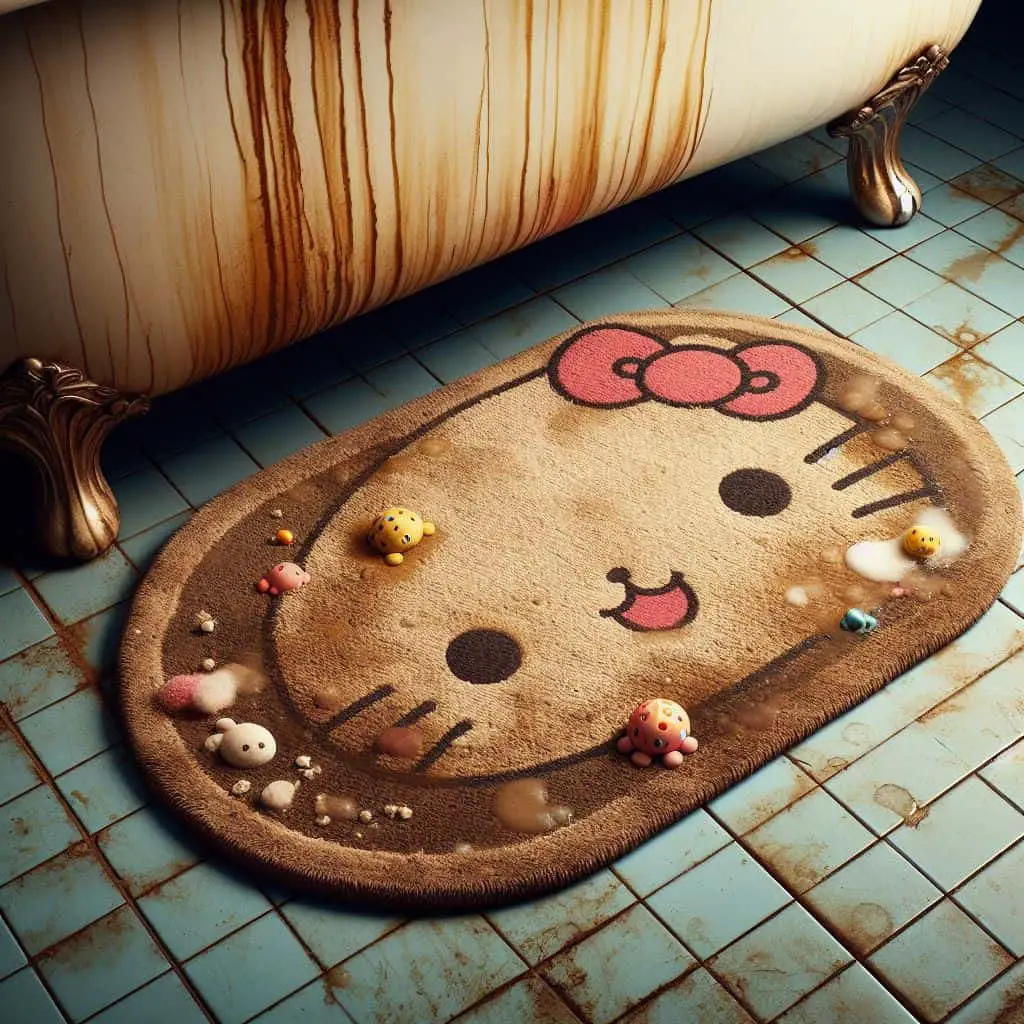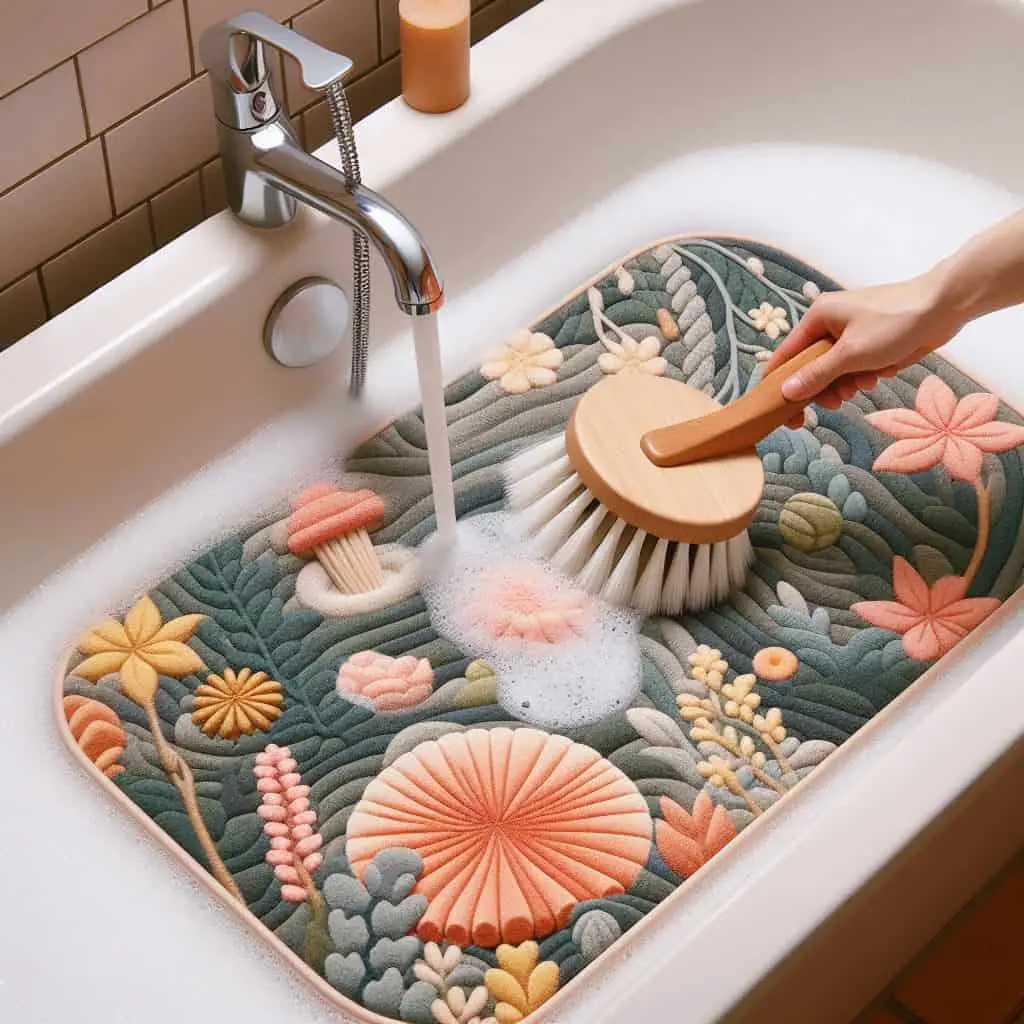Maintaining a clean and hygienic bathroom is essential, and this includes the often-overlooked accessory: the bathtub mat. Regularly washing your bathtub mat not only ensures safety against slips but also prevents the buildup of bacteria and mold, which can thrive in the damp environment of a bathroom.
In this blog, we’ll explore the question, “Can you wash a bathtub mat?” and delve into the best methods to do so, whether you can toss it into the washing machine or need to scrub it by hand.
We’ll also discuss how often you should clean your mat, the use of disinfectants, and how to tackle common issues like mold and stains.
Can You Wash a Bathtub Mat?
Yes, you can wash a bathtub mat. Most bathtub mats are designed to withstand regular cleaning, whether it’s in a washing machine or by hand. However, it’s crucial to check the manufacturer’s instructions before proceeding, as materials and care instructions can vary.
Typically, rubber and plastic mats are machine washable, while more delicate materials may require hand washing. Use gentle detergents and avoid harsh chemicals to keep your mat in top condition.

Can You Machine Wash Bathtub Mats?
A common query among homeowners is whether it’s safe to machine wash bathtub mats. The answer largely depends on the material composition of the mat. Many bathtub mats, particularly those made of rubber or plastic, are suitable for machine washing, which can be an effective and convenient way to keep them clean and free from bacteria and mildew.
Before tossing your mat into the washing machine, always check the care label for specific instructions provided by the manufacturer. If your mat is machine washable, follow these steps to ensure a thorough clean:
1.Preparation:
- Remove the mat from the tub and shake it to dislodge any loose dirt or debris.
- For mats with suction cups, ensure they are free from hair and other particles.
2. Washing:
- Place the mat in the washing machine by itself or with a load of towels. Towels will provide extra scrubbing action.
- Use a gentle, non-bleach laundry detergent to avoid breaking down the mat’s material.
- Set the washing machine to a gentle or delicate cycle with warm water to effectively sanitize the mat.
3. Additional Disinfecting (Optional):
- If you want to disinfect the mat further, you can add a half cup of white vinegar or baking soda to the load.
- Avoid using chlorine bleach unless the care label explicitly states it’s safe, as it can degrade certain materials.
4. Drying:
- After the wash cycle is complete, remove the mat and hang it outside to air dry if possible. Sunlight has a natural sanitizing effect.
- Alternatively, you can lay it flat to dry. Avoid using the dryer unless the care label indicates it’s safe, as high heat can warp or damage the mat.
By following these instructions, you can ensure that your bathtub mat is not only clean but also maintains its integrity and safety features. Remember that consistent maintenance is key to prolonging the life of your mat and protecting your family from bathroom germs.
What Are the Best Practices for Hand Washing Bathtub Mats?
Not all bathtub mats are suitable for machine washing, especially those with unique materials or specific care instructions. Hand washing is an excellent alternative that can effectively clean and maintain the quality of your bathtub mat. Here are the best practices to hand wash your mat, broken down into a step-by-step guide:

| Step | Action | Details |
|---|---|---|
| 1 | Preparation | Begin by removing the mat from the tub and shaking off any loose dirt or debris. |
| 2 | Pre-Treat | For areas with mildew or stains, apply a mixture of baking soda and water to the spot and gently scrub with a brush. |
| 3 | Fill the Tub | Fill your bathtub with warm water, ensuring it’s enough to cover the mat. Add a couple of drops of a mild detergent or dish soap to create a cleaning solution. |
| 4 | Submerge the Mat | Place the mat in the soapy water, making sure it’s fully submerged. For added cleaning power, you can also add a cup of white vinegar. |
| 5 | Scrub | Use a soft brush or sponge to gently scrub the mat’s surface, paying extra attention to textured areas and suction cups. |
| 6 | Soak | Allow the mat to soak for at least 15 to 30 minutes, letting the cleaning solution do its work. |
| 7 | Rinse Thoroughly | After soaking, drain the tub and rinse the mat with clean water to remove any soap residue. |
| 8 | Dry Completely | Hang the mat outside to air dry if possible, as sunlight helps to kill any remaining bacteria. If outdoor drying isn’t an option, lay the mat flat in a well-ventilated area. |
Always ensure the mat is completely dry before placing it back in the tub to prevent mold and mildew growth. Regular hand washing can extend the life of your bathtub mat and keep it hygienic for everyday use. Remember, the key to a successfully hand-washed mat is gentle care and thorough drying.
How Often Should You Wash Your Bathtub Mat?
Deciding on the frequency of washing your bathtub mat is crucial for maintaining a clean and safe bathroom environment. Since bathtub mats are consistently exposed to moisture, they can become breeding grounds for bacteria, mold, and mildew if not cleaned regularly.
As a general rule, aim to wash your bathtub mat at least once every two weeks. However, several factors can influence how often you should wash it:
- Usage Frequency: If the mat is in a bathroom that sees heavy traffic, such as from a large family or roommates, you might need to wash it weekly.
- Humidity Levels: Bathrooms with poor ventilation that remain damp for longer periods may require more frequent mat washings to prevent mold growth.
- Spills and Stains: If the mat gets stained or if personal care products spill on it, immediate cleaning is necessary to prevent permanent damage.
- Illness: After illness in the household, wash the mat to prevent the spread of germs.
Between washings, you can take steps to keep your mat cleaner:
- After each use, hang the mat to allow it to dry fully, which reduces the likelihood of bacteria and mold growth.
- Rinse the mat quickly after use to wash away any soap residue or hair.
- Use a bathroom fan or dehumidifier to lower humidity levels.
It’s not just about sticking to a schedule; it’s also about being attentive to the condition of your bathtub mat. If it starts to smell, shows visible signs of mold or mildew, or feels slimy, it’s time for a wash, even if it hasn’t been two weeks since the last cleaning.
In conclusion, regular washing of your bathtub mat is essential for hygiene and safety. Adjust the cleaning frequency based on your bathroom’s usage and conditions, and always ensure that the mat is completely dry before using it again. This will help to keep your bathroom sanitary, fresh, and slip-free.
Can You Use Bleach or Other Disinfectants on Bathtub Mats?

Using bleach or other disinfectants on bathtub mats is a common consideration for those looking to achieve a deep clean and eliminate germs. While these products can be effective sanitizers, it’s important to use them cautiously to avoid damaging the mat or creating a hazardous environment.
Firstly, always refer to the manufacturer’s care instructions. Some mats may be resistant to bleach and harsh chemicals, while others can deteriorate or discolor. If the mat is bleach-safe, you can proceed with the following guidelines:
1 . Diluted Bleach Solution:
- Mix a small amount of bleach with a large volume of water (typically one tablespoon of bleach per gallon of water) for a safe yet effective cleaning solution.
- Submerge the mat in the solution, ensuring all parts are covered, and let it soak for a few minutes.
2. Direct Application:
- For targeted cleaning of stains or mildew, you might apply a bleach-based cleaner directly to the affected area.
- Scrub gently with a brush and rinse thoroughly afterward.
3. Alternative Disinfectants:
- If you prefer not to use bleach, consider other disinfectants like hydrogen peroxide or vinegar for a more natural approach.
- These alternatives can be effective against bacteria and are less likely to cause damage to various mat materials.
4. Safety Measures:
- When using disinfectants, ensure the bathroom is well-ventilated to prevent inhaling fumes.
- Wear gloves to protect your skin and avoid mixing different chemicals, which can create toxic gases.
It’s essential to rinse the mat thoroughly after using any disinfectant to remove all chemical residues. Once clean, hang the mat to dry completely before placing it back in the tub.
To sum up, while you can use bleach and other disinfectants on many bathtub mats, it’s critical to do so with care. Not all mats are created equal, and the wrong chemical can do more harm than good. Always prioritize safety for both the mat and yourself, and when in doubt, opt for gentler cleaning methods.
Troubleshooting Common Issues: Removing Mold, Mildew, and Stains
Bathtub mats are prone to developing mold, mildew, and stains due to the damp conditions of bathrooms. Addressing these common issues promptly can extend the life of your mat and ensure it remains hygienic. Here’s how to tackle each problem effectively:
Removing Mold and Mildew:
- Vinegar Solution: White vinegar is a natural antimicrobial that can kill mold and mildew. Spray full-strength vinegar onto the affected area, let it sit for an hour, then scrub with a brush and rinse.
- Baking Soda Paste: Create a thick paste using baking soda and a bit of water. Apply it to the moldy spots, scrub with a brush, then rinse off.
- Tea Tree Oil: Mix a teaspoon of tea tree oil with a cup of water. Spray it on the mold, do not rinse, and let it dry. Tea tree oil is a natural fungicide and can discourage mold growth.
Removing Stains:
- Hydrogen Peroxide: For light-colored mats, hydrogen peroxide can act as a mild bleach. Apply it to the stain, let it sit for a few minutes, then scrub and rinse.
- Oxygen-Based Bleach: Mix oxygen-based bleach with water according to the package instructions. Soak the mat in the solution for a few hours, then rinse thoroughly.
- Lemon and Salt: For non-porous mats, lemon juice and salt can help remove stains. Sprinkle salt on the stain, squeeze lemon juice over it, let it sit, then scrub and rinse.
For both mold/mildew and stains, it’s important to:
- Test Cleaners: Always do a spot test with your chosen cleaner in an inconspicuous area to ensure it doesn’t damage the mat.
- Use Protective Gear: When using any cleaning agent, wear gloves to protect your hands and ensure the room is well-ventilated.
- Dry Thoroughly: After cleaning, make sure to dry the mat completely in a well-ventilated area or in direct sunlight to prevent future growth of mold and mildew.
Regular maintenance and immediate attention to spills and mildew can keep your bathtub mat looking and smelling fresh. Don’t let these common issues shorten the life of your mat; with the right approach, you can keep it in great condition for years to come.
Conclusion
In summary, tackling the question “Can you wash a bathtub mat?” is essential for a clean and hygienic bathroom. Through regular washing, either by machine or hand, and addressing issues such as mold, mildew, and stains promptly, you can extend the life of your bathtub mat and ensure a safe, slip-free surface.
Always remember to consult the care label, use appropriate cleaning methods, and allow your mat to dry completely to maintain its condition. Keeping your bathtub mat clean is a simple yet crucial step in upholding the overall cleanliness of your home.
